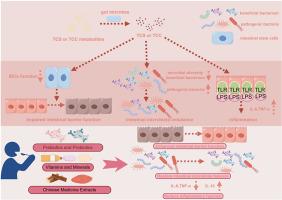三氯生和三氯卡班的肠道毒性机制及其可能的临床营养干预机制
IF 7.3
2区 环境科学与生态学
Q1 ENVIRONMENTAL SCIENCES
引用次数: 0
摘要
三氯生(TCS)和三氯卡班(TCC)作为抗菌药物广泛应用于个人护理产品中。它们的广泛使用已成为一种潜在的环境污染物。本文综述了TCS和TCC的肠道毒性机制及其潜在的营养干预策略。TCS和TCC可在宿主体内代谢为葡萄糖醛酸偶联物,随后被肠道内的微生物解偶联,再生游离形式的TCS和TCC。TCS和TCC是独特的代谢途径,它们在肠道内积累,改变肠道菌群结构,增加致病菌的相对丰度,同时降低有益菌的丰度,从而破坏肠道菌群的平衡。此外,它们可以干扰ISCs的自我更新和分化,从而削弱肠道屏障功能。TCS和TCC还能激活TLR4-NFκB信号通路,诱导和加重炎症反应。这些机制共同导致肠道毒性,并对肠道健康产生重大负面影响。为了应对这些作用机制引起的肠道毒性,本文认为益生元、益生菌、维生素、矿物质和草药提取物可以作为潜在的营养干预手段,通过调节肠道菌群、增强肠道屏障功能和抑制炎症反应来降低TCS和TCC的肠道毒性。虽然初步研究显示了这些干预措施的潜在益处,但其具体功效和安全性仍需进一步研究。本文章由计算机程序翻译,如有差异,请以英文原文为准。


The intestinal toxicity mechanisms of triclosan and triclocarban and their possible clinical nutritional intervention mechanisms
Triclosan (TCS) and triclocarban (TCC) are widely used as antimicrobial agents in personal care products. Their widespread use has become a potential environmental contaminant. This review reviews the mechanisms of intestinal toxicity of TCS and TCC and their potential nutritional intervention strategies. TCS and TCC can be metabolized to glucuronic acid conjugates in the host and subsequently uncoupled by microorganisms in the intestine to regenerate free forms of TCS and TCC. TCS and TCC are unique metabolic pathways that lead to accumulation in the gut, altering the structure of intestinal flora, increasing the relative abundance of pathogenic bacteria, while reducing the abundance of beneficial bacteria, thereby disrupting the balance of intestinal flora. In addition, they can interfere with the self-renewal and differentiation of ISCs, thereby weakening intestinal barrier function. TCS and TCC can also activate the TLR4-NFκB signaling pathway, inducing and exacerbating inflammatory responses. These mechanisms together lead to intestinal toxicity and have a significant negative impact on intestinal health. In order to cope with the intestinal toxicity caused by these mechanisms of action, this paper believes that prebiotics, probiotics, vitamins, minerals and herbal extracts can be used as potential nutritional interventions to reduce the intestinal toxicity of TCS and TCC by regulating intestinal microbiota, enhancing intestinal barrier function and inhibiting inflammatory response. Although preliminary studies have shown the potential benefits of these interventions, their specific efficacy and safety still need further study.
求助全文
通过发布文献求助,成功后即可免费获取论文全文。
去求助
来源期刊

Environmental Pollution
环境科学-环境科学
CiteScore
16.00
自引率
6.70%
发文量
2082
审稿时长
2.9 months
期刊介绍:
Environmental Pollution is an international peer-reviewed journal that publishes high-quality research papers and review articles covering all aspects of environmental pollution and its impacts on ecosystems and human health.
Subject areas include, but are not limited to:
• Sources and occurrences of pollutants that are clearly defined and measured in environmental compartments, food and food-related items, and human bodies;
• Interlinks between contaminant exposure and biological, ecological, and human health effects, including those of climate change;
• Contaminants of emerging concerns (including but not limited to antibiotic resistant microorganisms or genes, microplastics/nanoplastics, electronic wastes, light, and noise) and/or their biological, ecological, or human health effects;
• Laboratory and field studies on the remediation/mitigation of environmental pollution via new techniques and with clear links to biological, ecological, or human health effects;
• Modeling of pollution processes, patterns, or trends that is of clear environmental and/or human health interest;
• New techniques that measure and examine environmental occurrences, transport, behavior, and effects of pollutants within the environment or the laboratory, provided that they can be clearly used to address problems within regional or global environmental compartments.
 求助内容:
求助内容: 应助结果提醒方式:
应助结果提醒方式:


